Abstract
1. Short-latency responses of single motor units (SMUs) and surface electromyographic activity (EMG) to transcranial magnetic stimulation (TMS) were examined in five different hand and forearm muscles of human subjects. 2. The response probability, P (number of extra spikes in the response peak above background per stimulus), was, in general, higher at the lower voluntary discharge rate of the motor unit than at the higher rate. 3. Increasing the strength of TMS increased the response probability of a tonically firing motor unit and at the same time recruited new units which discharged phasically during the response peak. This demonstrates rate coding and recruitment of motor units by excitatory inputs resulting from TMS when the motoneurone pool is tonically facilitated by a constant voluntary drive. 4. Next, TMS was delivered without any voluntary facilitation of motoneurones. The order of recruitment for up to four different motor units discharged by TMS was compared to that observed with voluntary input. The threshold of recruitment for each of the two inputs was estimated from the surface EMG value at which the unit was recruited. For these motoneurone pools (eleven sets of observations), the order of recruitment was the same with TMS and voluntary inputs. 5. From these data it is concluded that, despite the complex and phasic nature of the descending corticospinal volleys generated by TMS, it produces orderly recruitment and rate coding of motoneurones similar to that found for voluntary activation.
Full text
PDF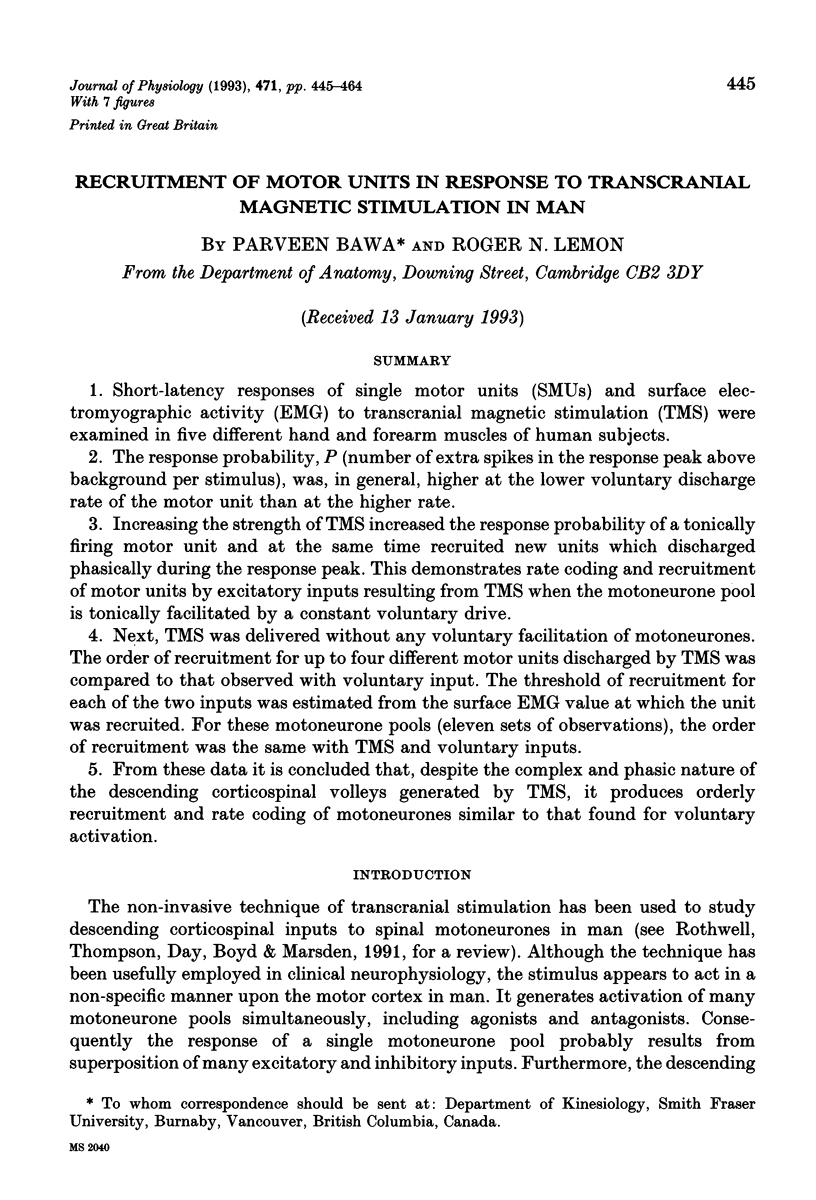
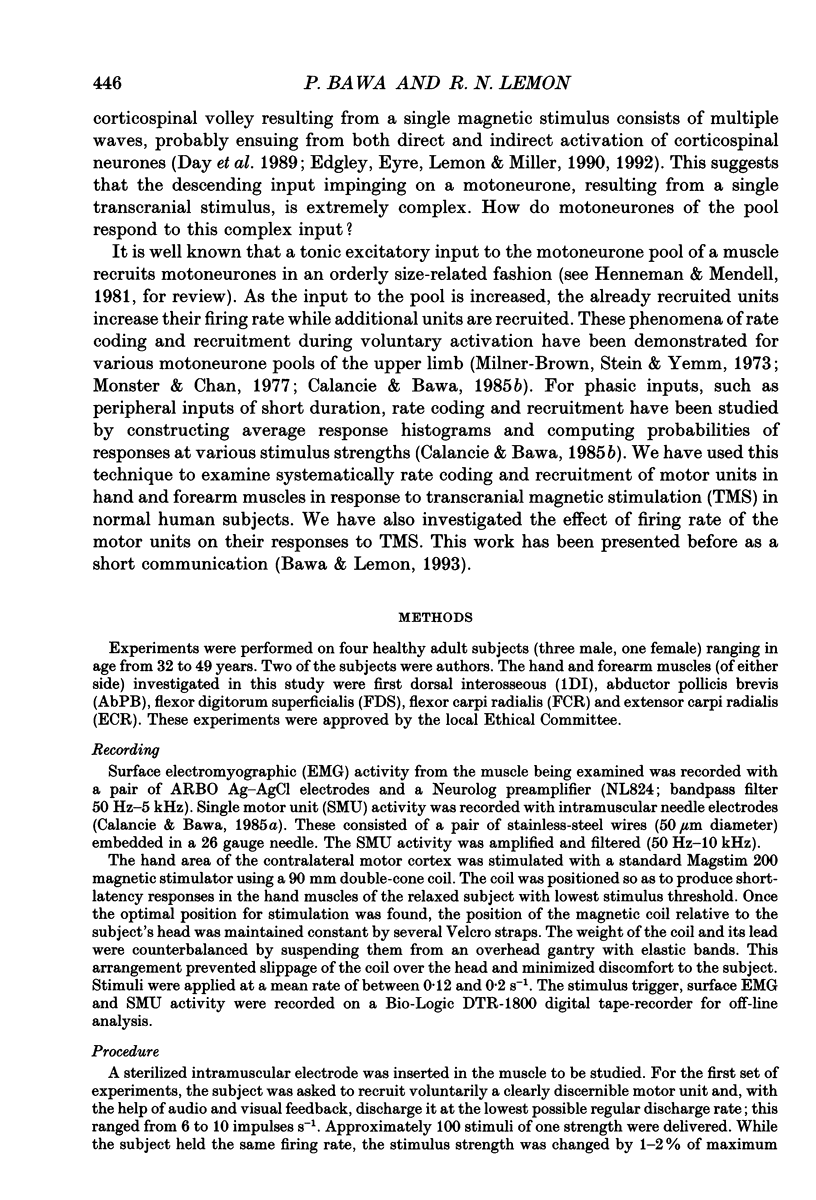

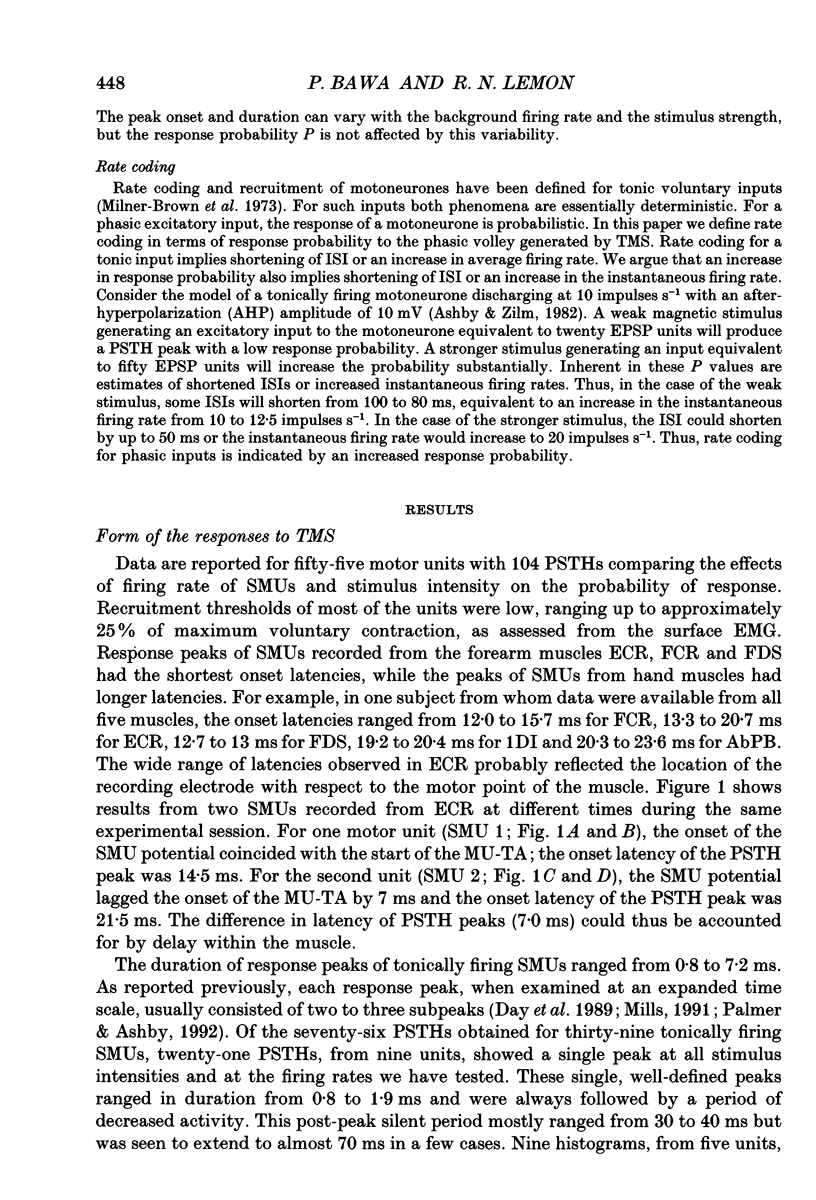
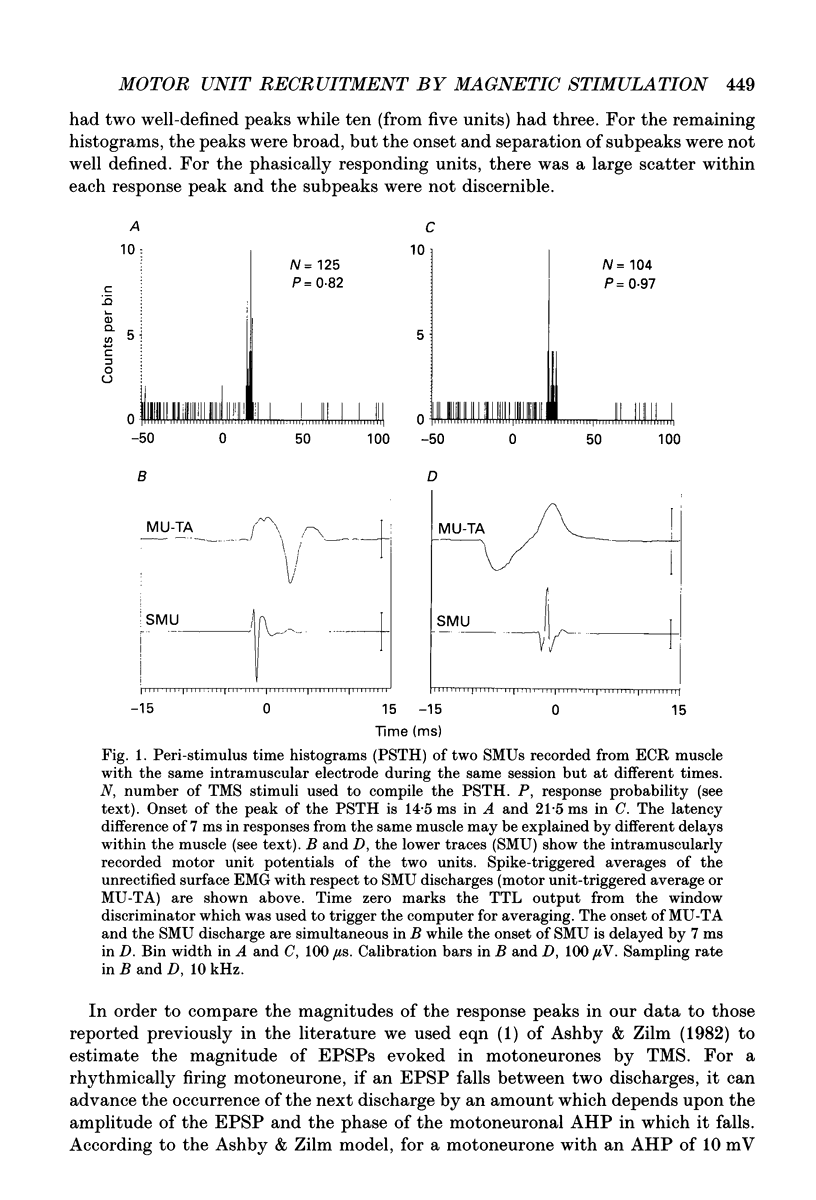
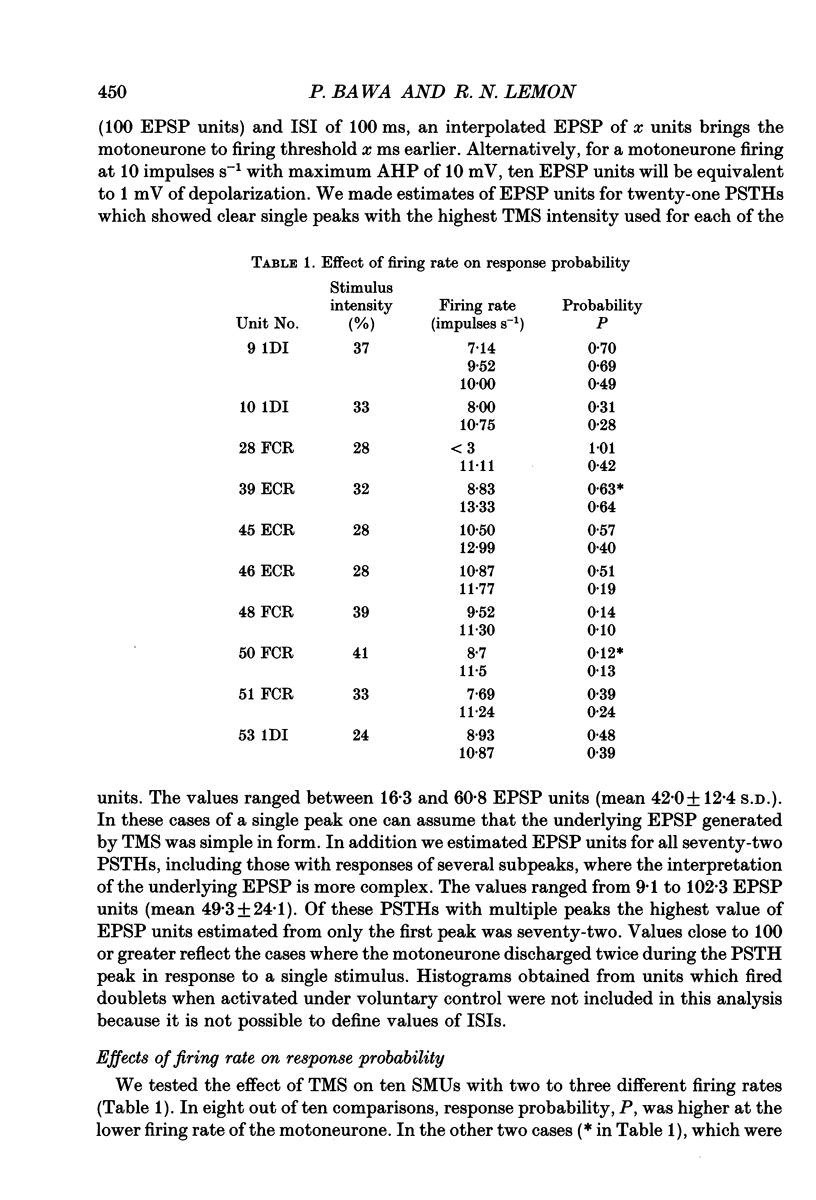
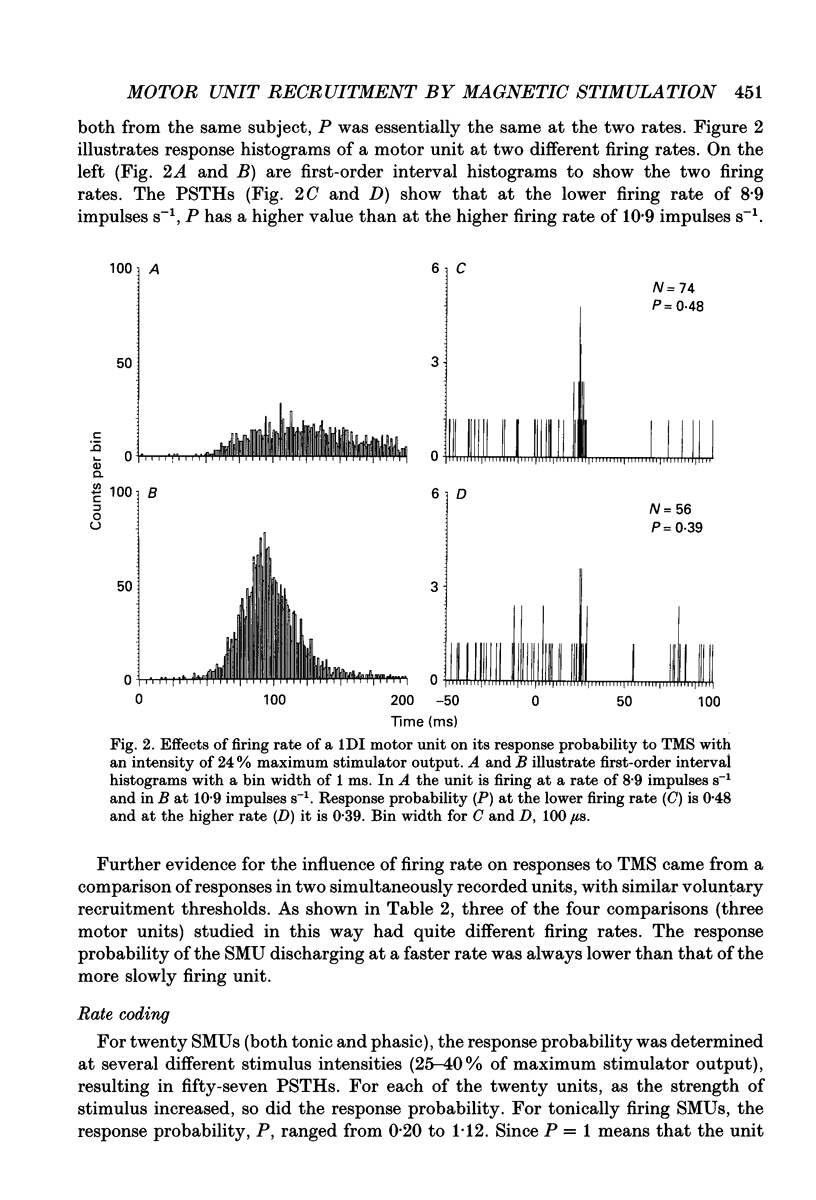
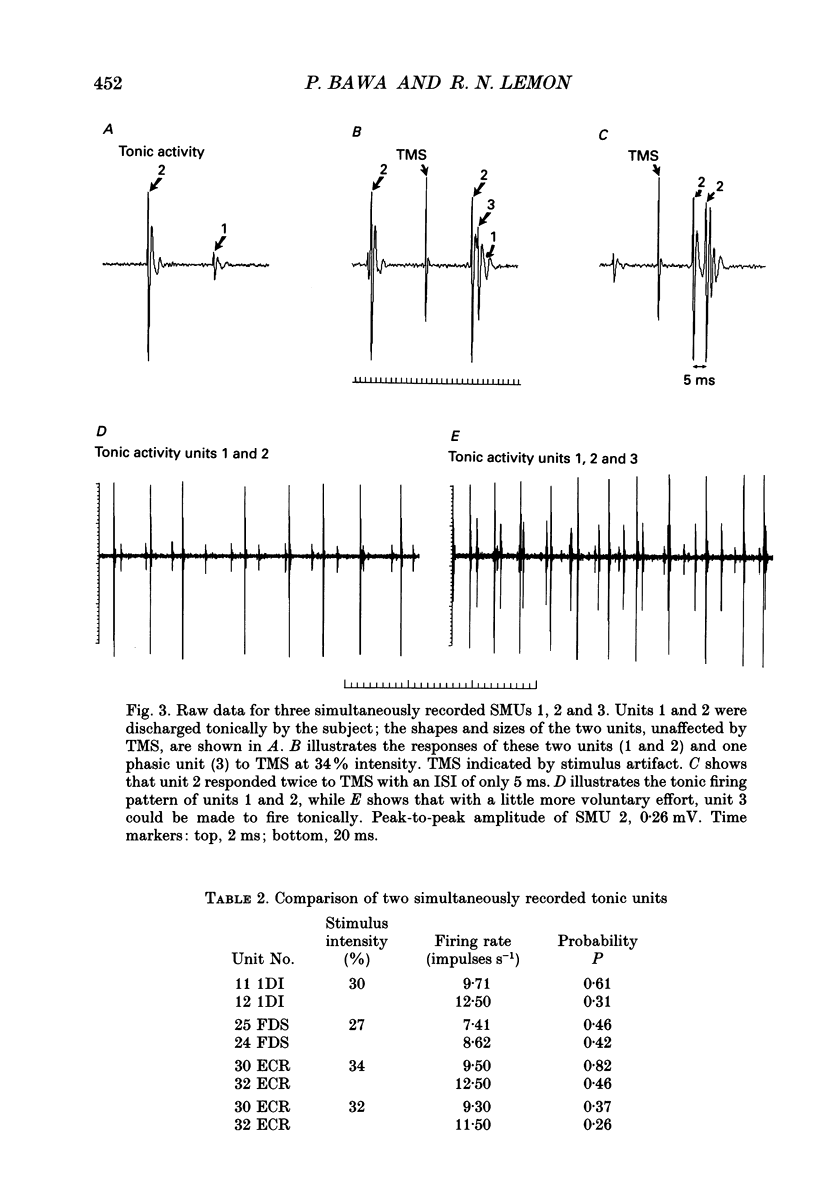

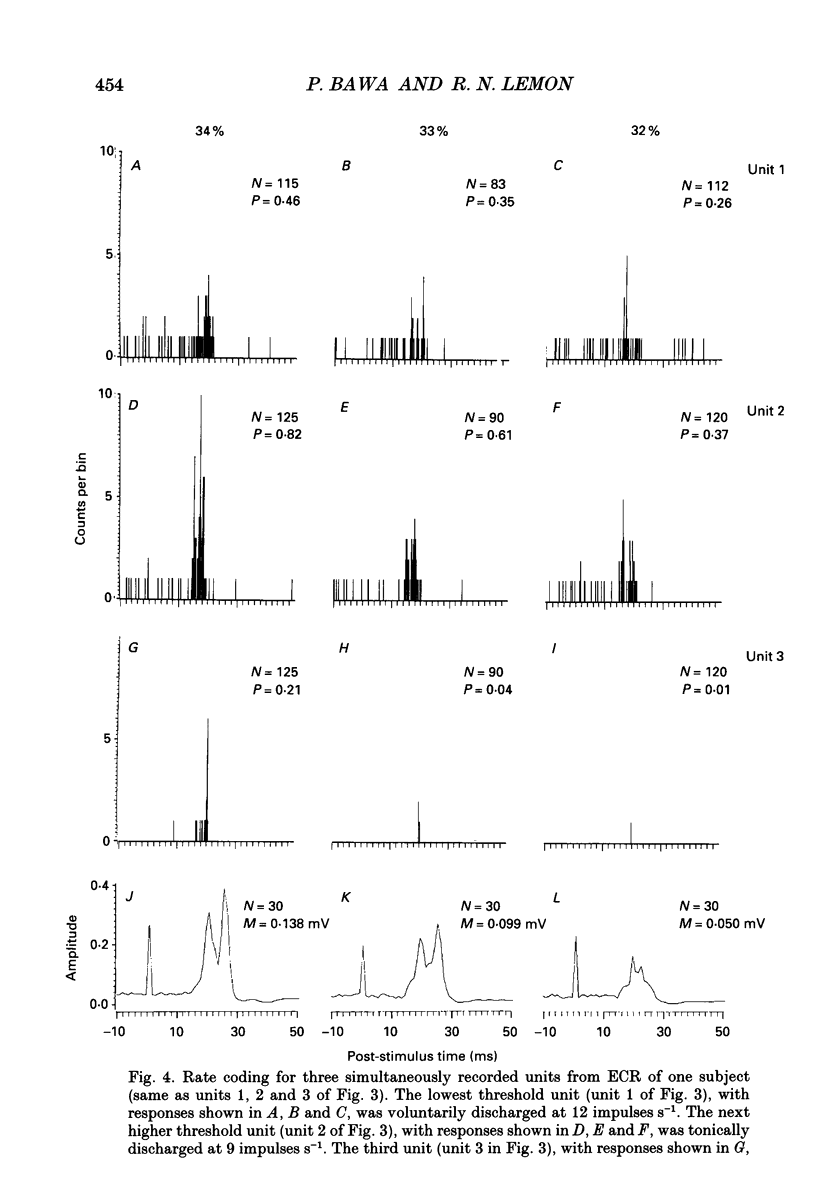
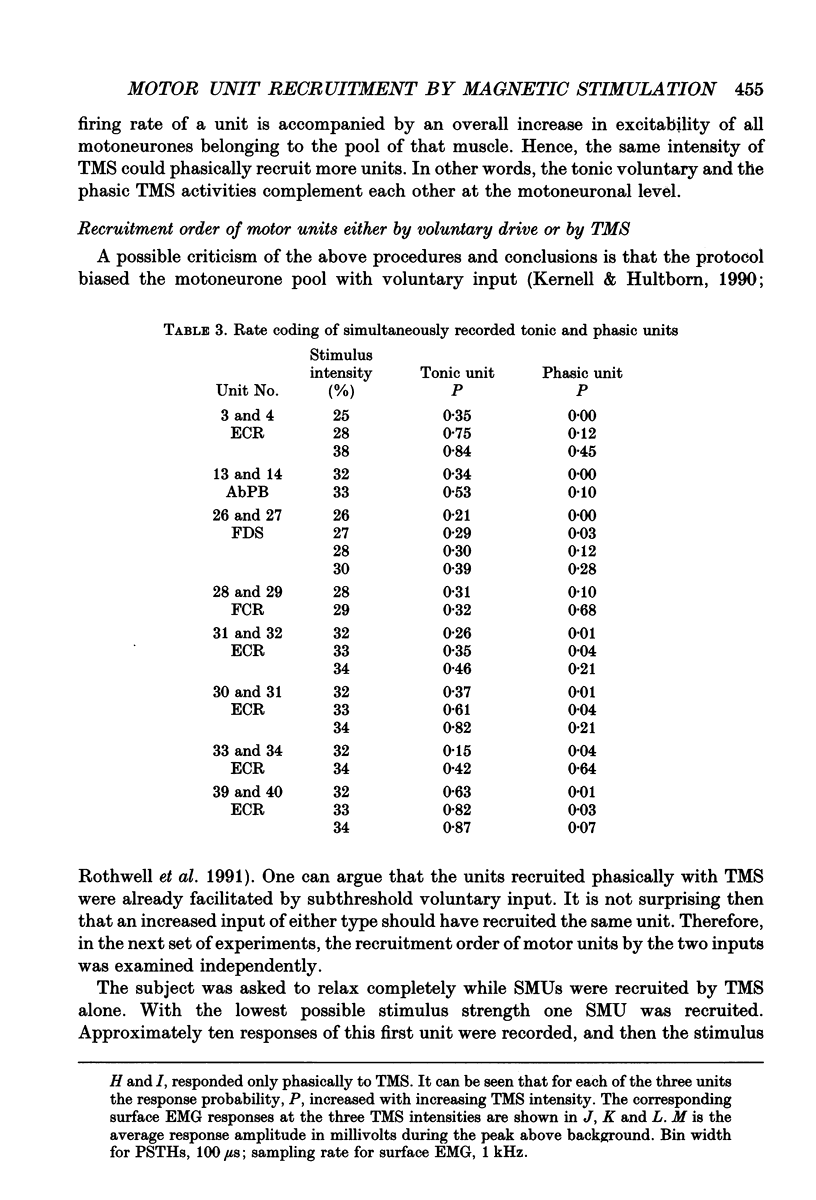


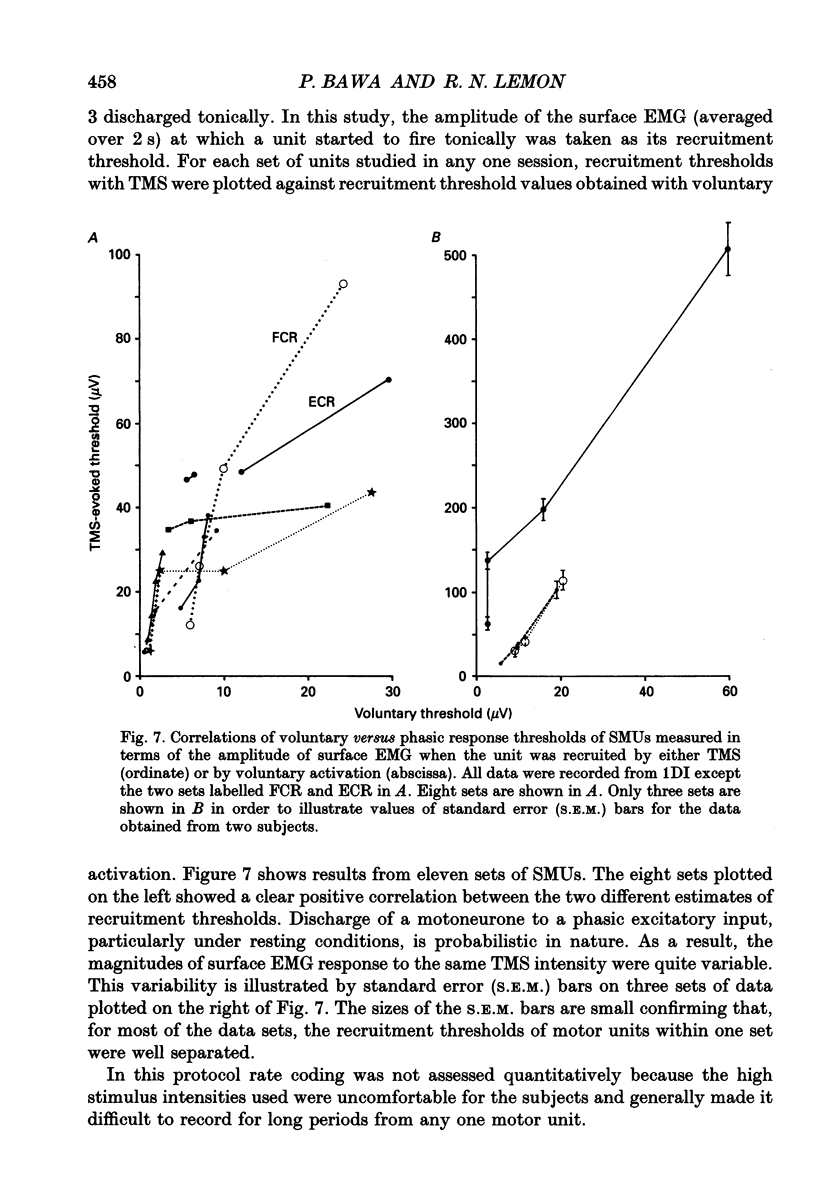
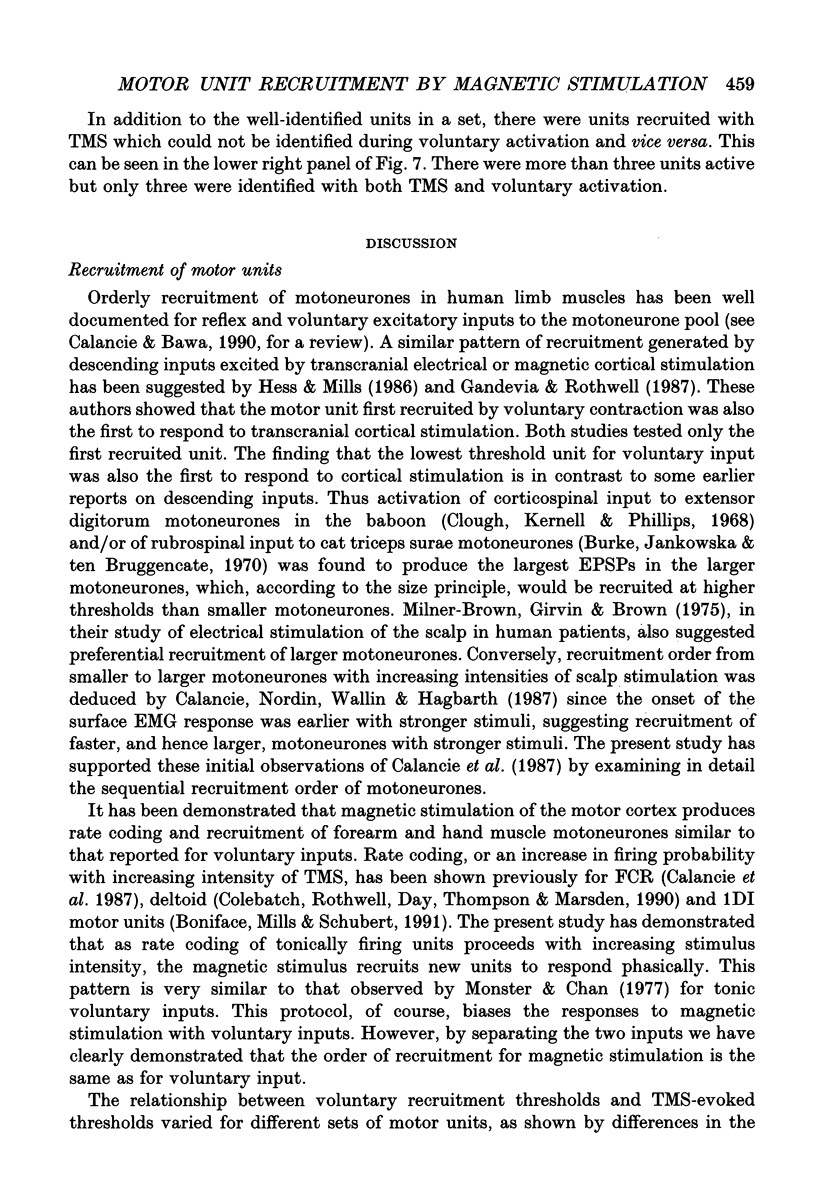


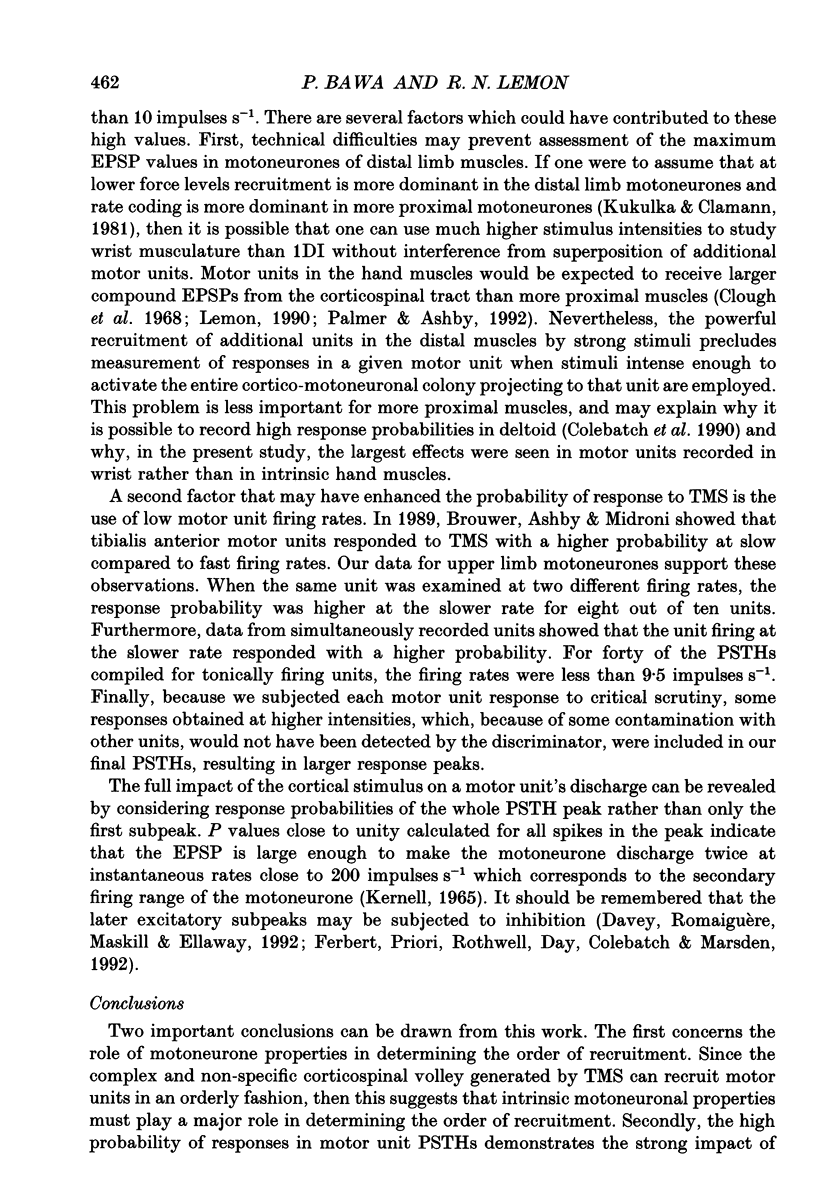

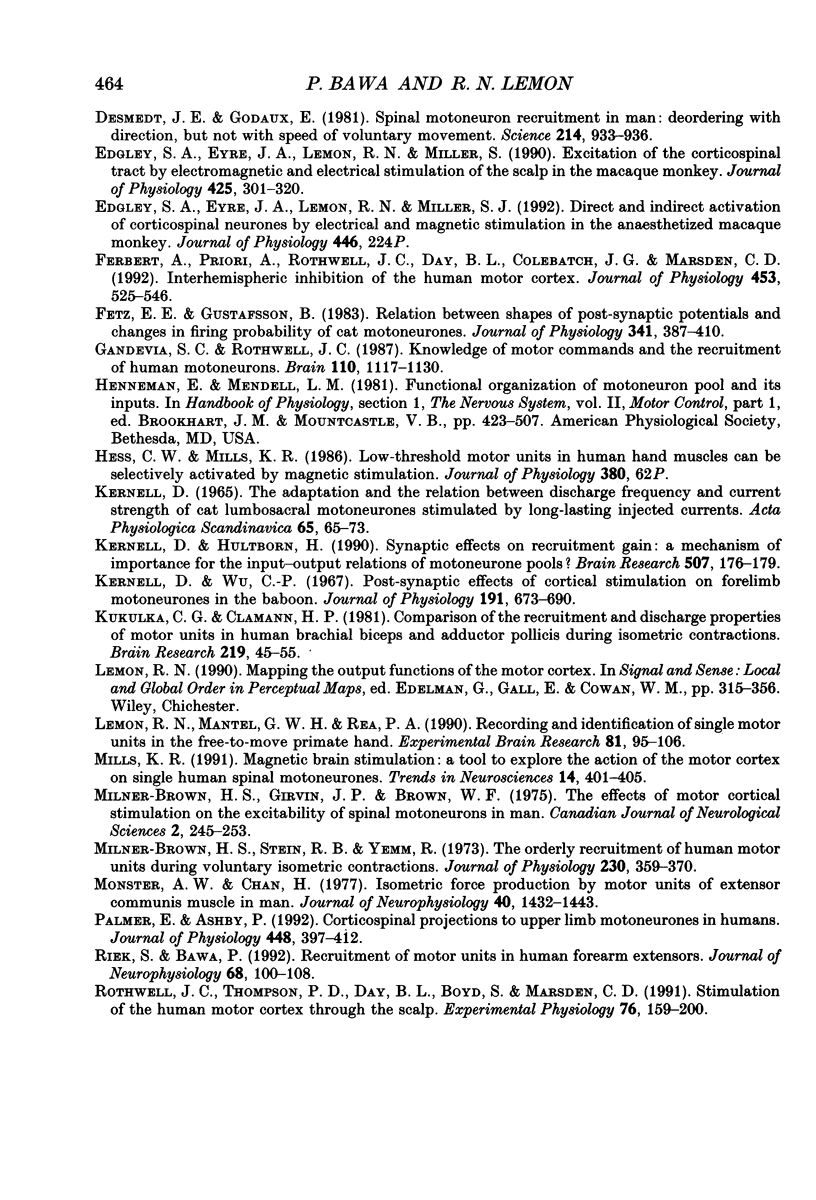
Selected References
These references are in PubMed. This may not be the complete list of references from this article.
- Ashby P., Zilm D. Relationship between EPSP shape and cross-correlation profile explored by computer simulation for studies on human motoneurons. Exp Brain Res. 1982;47(1):33–40. doi: 10.1007/BF00235883. [DOI] [PubMed] [Google Scholar]
- Bawa P., Calancie B. Repetitive doublets in human flexor carpi radialis muscle. J Physiol. 1983 Jun;339:123–132. doi: 10.1113/jphysiol.1983.sp014707. [DOI] [PMC free article] [PubMed] [Google Scholar]
- Boniface S. J., Mills K. R., Schubert M. Responses of single spinal motoneurons to magnetic brain stimulation in healthy subjects and patients with multiple sclerosis. Brain. 1991 Feb;114(Pt 1B):643–662. doi: 10.1093/brain/114.1.643. [DOI] [PubMed] [Google Scholar]
- Brouwer B., Ashby P., Midroni G. Excitability of corticospinal neurons during tonic muscle contractions in man. Exp Brain Res. 1989;74(3):649–652. doi: 10.1007/BF00247369. [DOI] [PubMed] [Google Scholar]
- Burke D., Hicks R., Gandevia S. C., Stephen J., Woodforth I., Crawford M. Direct comparison of corticospinal volleys in human subjects to transcranial magnetic and electrical stimulation. J Physiol. 1993 Oct;470:383–393. doi: 10.1113/jphysiol.1993.sp019864. [DOI] [PMC free article] [PubMed] [Google Scholar]
- Burke R. E., Jankowska E., ten Bruggencate G. A comparison of peripheral and rubrospinal synaptic input to slow and fast twitch motor units of triceps surae. J Physiol. 1970 May;207(3):709–732. doi: 10.1113/jphysiol.1970.sp009090. [DOI] [PMC free article] [PubMed] [Google Scholar]
- Calancie B., Bawa P. Firing patterns of human flexor carpi radialis motor units during the stretch reflex. J Neurophysiol. 1985 May;53(5):1179–1193. doi: 10.1152/jn.1985.53.5.1179. [DOI] [PubMed] [Google Scholar]
- Calancie B., Bawa P. Voluntary and reflexive recruitment of flexor carpi radialis motor units in humans. J Neurophysiol. 1985 May;53(5):1194–1200. doi: 10.1152/jn.1985.53.5.1194. [DOI] [PubMed] [Google Scholar]
- Calancie B., Nordin M., Wallin U., Hagbarth K. E. Motor-unit responses in human wrist flexor and extensor muscles to transcranial cortical stimuli. J Neurophysiol. 1987 Nov;58(5):1168–1185. doi: 10.1152/jn.1987.58.5.1168. [DOI] [PubMed] [Google Scholar]
- Clamann H. P., Gillies J. D., Skinner R. D., Henneman E. Quantitative measures of output of a motoneuron pool during monosynaptic reflexes. J Neurophysiol. 1974 Nov;37(6):1328–1337. doi: 10.1152/jn.1974.37.6.1328. [DOI] [PubMed] [Google Scholar]
- Clough J. F., Kernell D., Phillips C. G. The distribution of monosynaptic excitation from the pyramidal tract and from primary spindle afferents to motoneurones of the baboon's hand and forearm. J Physiol. 1968 Sep;198(1):145–166. doi: 10.1113/jphysiol.1968.sp008598. [DOI] [PMC free article] [PubMed] [Google Scholar]
- Colebatch J. G., Rothwell J. C., Day B. L., Thompson P. D., Marsden C. D. Cortical outflow to proximal arm muscles in man. Brain. 1990 Dec;113(Pt 6):1843–1856. doi: 10.1093/brain/113.6.1843. [DOI] [PubMed] [Google Scholar]
- Day B. L., Dressler D., Maertens de Noordhout A., Marsden C. D., Nakashima K., Rothwell J. C., Thompson P. D. Electric and magnetic stimulation of human motor cortex: surface EMG and single motor unit responses. J Physiol. 1989 May;412:449–473. doi: 10.1113/jphysiol.1989.sp017626. [DOI] [PMC free article] [PubMed] [Google Scholar]
- Day B. L., Rothwell J. C., Thompson P. D., Dick J. P., Cowan J. M., Berardelli A., Marsden C. D. Motor cortex stimulation in intact man. 2. Multiple descending volleys. Brain. 1987 Oct;110(Pt 5):1191–1209. doi: 10.1093/brain/110.5.1191. [DOI] [PubMed] [Google Scholar]
- Desnedt H. E., Gidaux E. Spinal motoneuron recruitment in man: rank deordering with direction but not with speed of voluntary movement. Science. 1981 Nov 20;214(4523):933–936. doi: 10.1126/science.7302570. [DOI] [PubMed] [Google Scholar]
- Edgley S. A., Eyre J. A., Lemon R. N., Miller S. Excitation of the corticospinal tract by electromagnetic and electrical stimulation of the scalp in the macaque monkey. J Physiol. 1990 Jun;425:301–320. doi: 10.1113/jphysiol.1990.sp018104. [DOI] [PMC free article] [PubMed] [Google Scholar]
- Ferbert A., Priori A., Rothwell J. C., Day B. L., Colebatch J. G., Marsden C. D. Interhemispheric inhibition of the human motor cortex. J Physiol. 1992;453:525–546. doi: 10.1113/jphysiol.1992.sp019243. [DOI] [PMC free article] [PubMed] [Google Scholar]
- Fetz E. E., Gustafsson B. Relation between shapes of post-synaptic potentials and changes in firing probability of cat motoneurones. J Physiol. 1983 Aug;341:387–410. doi: 10.1113/jphysiol.1983.sp014812. [DOI] [PMC free article] [PubMed] [Google Scholar]
- Gandevia S. C., Rothwell J. C. Knowledge of motor commands and the recruitment of human motoneurons. Brain. 1987 Oct;110(Pt 5):1117–1130. doi: 10.1093/brain/110.5.1117. [DOI] [PubMed] [Google Scholar]
- Kernell D., Chien-Ping W. Post-synaptic effects of cortical stimulation on forelimb motoneurones in the baboon. J Physiol. 1967 Aug;191(3):673–690. doi: 10.1113/jphysiol.1967.sp008274. [DOI] [PMC free article] [PubMed] [Google Scholar]
- Kernell D., Hultborn H. Synaptic effects on recruitment gain: a mechanism of importance for the input-output relations of motoneurone pools? Brain Res. 1990 Jan 15;507(1):176–179. doi: 10.1016/0006-8993(90)90542-j. [DOI] [PubMed] [Google Scholar]
- Kukulka C. G., Clamann H. P. Comparison of the recruitment and discharge properties of motor units in human brachial biceps and adductor pollicis during isometric contractions. Brain Res. 1981 Aug 24;219(1):45–55. doi: 10.1016/0006-8993(81)90266-3. [DOI] [PubMed] [Google Scholar]
- Lemon R. N., Mantel G. W., Rea P. A. Recording and identification of single motor units in the free-to-move primate hand. Exp Brain Res. 1990;81(1):95–106. doi: 10.1007/BF00230105. [DOI] [PubMed] [Google Scholar]
- Mills K. R. Magnetic brain stimulation: a tool to explore the action of the motor cortex on single human spinal motoneurones. Trends Neurosci. 1991 Sep;14(9):401–405. doi: 10.1016/0166-2236(91)90029-t. [DOI] [PubMed] [Google Scholar]
- Milner-Brown H. S., Stein R. B., Yemm R. The orderly recruitment of human motor units during voluntary isometric contractions. J Physiol. 1973 Apr;230(2):359–370. doi: 10.1113/jphysiol.1973.sp010192. [DOI] [PMC free article] [PubMed] [Google Scholar]
- Milner-Brown S. H., Girvin J. P., Brown W. F. The effects of motor cortical stimulation on the excitability of spinal motoneurons in man. Can J Neurol Sci. 1975 Aug;2(3):245–253. doi: 10.1017/s0317167100020345. [DOI] [PubMed] [Google Scholar]
- Monster A. W., Chan H. Isometric force production by motor units of extensor digitorum communis muscle in man. J Neurophysiol. 1977 Nov;40(6):1432–1443. doi: 10.1152/jn.1977.40.6.1432. [DOI] [PubMed] [Google Scholar]
- Palmer E., Ashby P. Corticospinal projections to upper limb motoneurones in humans. J Physiol. 1992 Mar;448:397–412. doi: 10.1113/jphysiol.1992.sp019048. [DOI] [PMC free article] [PubMed] [Google Scholar]
- Riek S., Bawa P. Recruitment of motor units in human forearm extensors. J Neurophysiol. 1992 Jul;68(1):100–108. doi: 10.1152/jn.1992.68.1.100. [DOI] [PubMed] [Google Scholar]
- Rothwell J. C., Thompson P. D., Day B. L., Boyd S., Marsden C. D. Stimulation of the human motor cortex through the scalp. Exp Physiol. 1991 Mar;76(2):159–200. doi: 10.1113/expphysiol.1991.sp003485. [DOI] [PubMed] [Google Scholar]


